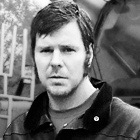ABOUT
Placard Flinger, 1995
Since 1990, Paine began showing his work in Williamsburg, Brooklyn where he cofounded the artist collective Brand Name Damages. With early works such as Where I’m at, Dinner of the Dictators and Placard Flinger,
Paine established an early interest in the collision of conflicting impulses of information such as industry and nature, control and chaos, form and theory.
During this time, Paine exhibited in several iconic group shows, such as Fever at Exit Art, Desire and Deception at Brand Name Damages and Human/Nature at the New Museum of Contemporary Art. In 1991, he had his first solo exhibition at the Knitting Factory in New York City.
Over the years, Paine's work has evolved into a trajectory of several overlapping wavelengths: machines, fields, fungus and weeds, specimen cases, dendroids and, most recently, dioramas.
Paine’s series of dioramas are contemporary discussions in human industries and human nature as they inform and reform the collective space. Paine's dioramas emerge as psychological, constructed realities of universal “habitats,” no longer present with human figures. They are the everyday spaces of our modern conditions such as a fast-food counter, a control room, a sports arena, a security line.
Meeting, 2016
PMU (Painting Manufacture Unit) 1999-2000
The vocabulary of fungi, plants and industrial machines became vehicles for the artist’s reflections on mechanized production and the human impulse to impose order and control over creative and natural forces. For example, in Drug Ziggurat (1993), Paine demonstrates an industrious approach to addressing systems and categories: mind-altering substances stack in a hierarchical order of potency, from a base of alcoholic and caffeinated beverages to a spire of hypodermic needles and opiates.
His art-making machines, such as the Paint Dipper, PMU (Painting Manufacture Unit) and the Erosion Machine juxtapose two conflicting impulses: the constraints imposed by data and code systems against the randomness of nature and chance. Paine’s “factories” resemble utilitarian models of production, but their results become questionable creations full of inefficiencies and nonidentical works.
“The blissed out or bored machine, who can tell, makes anywhere from between 80 and 200 passes-depending on the size of the canvas and thickness of the paint surface desired. Time seems to stand still,” writes Tan Lin. “Paine makes machines addicted to making paintings, to the labor of painting.
Crop (detail) 1997
He also makes hallucinatory, exquisitely unperturbed and minutely controlled replicas of mushrooms and poppies out of polymer.” Paine’s replicas - from a garden choked by weeds to a poppy flower oozing with harvest - transcribe the ordinary object into the psychoactive event.
The collapse of industry upon nature is further seen in Paine’s stainless steel dendroids. The dendroids, defined as anything branching or dendritic in structure, began as an early tree-like form in Bluff, exhibited in Central Park’s Whitney Biennial 2002, and evolved into the groundbreaking, neural and synaptic systems of Maelstrom exhibited on the rooftop of the Metropolitan Museum of Art 2009. Paine’s interest in stainless steel derives from its institutional use in pharmaceutical, food, gas and oil pipeline industries. The dendroids began as a study of growth patterns in nature and developed into Paine’s recent interest in structures of the human brain and nervous system. This transformation can be seen in such works as One Hundred Foot Line, Neuron, Inversion and Ferment.
Inversion, 2008
Roxy Paine was born in 1966 in New York. Since 1989, his work has been internationally exhibited and is included in collections such as Museum of Contemporary Art, Los Angeles, CA, San Francisco Museum of Modern Art, CA, Museum of Modern Art, NY, Whitney Museum of American Art, NY, Hirshhorn Museum, Washington, DC, National Gallery of Canada, Ottawa, and the Israel Museum, Jerusalem. He is the recipient of a John Simon Guggenheim Memorial Foundation Fellowship. He has permanently sited works at the Olympic Sculpture Park, Seattle, WA, National Gallery of Art, DC, Nelson Atkins Museum of Art, Kansas City, Missouri, the Modern Art Museum of Fort Worth, Texas and the Wanas Foundation, Sweden.
Paine is represented by Kasmin in NYC and Kavi Gupta Chicago | Berlin. He lives and works in New York.


